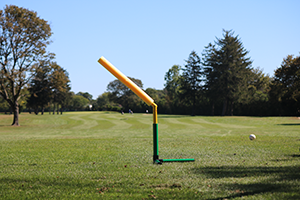The Straight Path Training Aid
For many people, golf is a sport that appears to be of a low magnitude and requires minimum or average strength, but the fact remains golf demands impressive and meticulous levels of practice and training just like other sports. There are many golf swing improver tools on the market, but few provide simplicity, allowing for a clearer understanding of complicated swing fundamentals and ball flight.
The average golfer tends to:
- Slice the golf ball, hitting the ball from an outside path. To prevent a slice, the golfer must learn to swing the club from an inside path.
- Flip their wrists through impact position, which changes the angle on which the golf ball is struck, leading to an inconsistent ball flight.
- Over-sway during their golf swing, which changes their spine angle, limits body rotation and prevents proper weight transfer, potentially leading to physical injury.
Other devices or systems do not offer the functionality, versatility or transportability of the Straight Path. They may only have one use, or work in one way; or may be larger or bulkier in size and not have the ability to be easily disassembled or transported for use in other locations. The Straight Path is extremely versatile. It can adjust to accommodate height differences in golfers, making it suitable for both adults and children.
Straight Path can be used to correct a slice, as well as provide immediate feedback for wrist flipping or body swaying. It can easily assemble and disassemble in less than one minute and comes with a carrier bag for easy and compact storage and transportability, allowing golfers to bring their swing aid from their home, to a driving range, to a golf practice area or an open field. Because of its lightweight design, it can also be easily used indoors as well.






